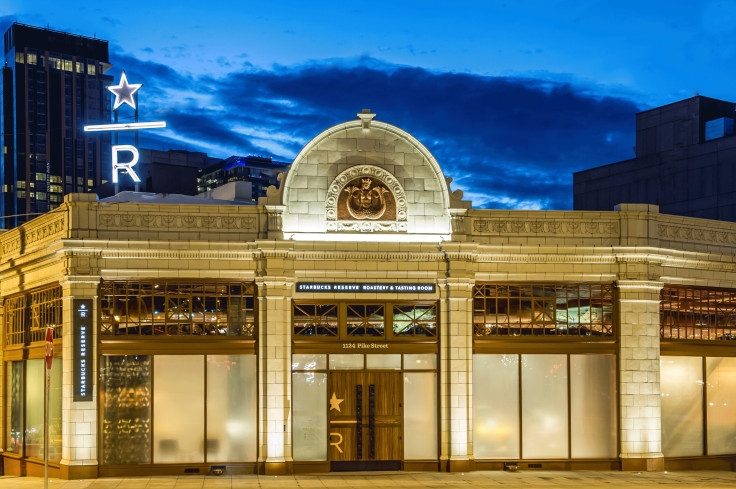Starbucks Corporation (NASDAQ:SBUX) First Quarter Earnings: How To Stop Slowing US Sales Growth While Expanding In China

Starbucks Corporation was once the symbol of small luxury, offering high-priced cappuccinos in pretentiously named cup sizes. Today, the world’s largest coffee roaster is ubiquitous in the U.S., with 21,000 stores located along highways, nestled in the corners of shopping outlets -- and practically adjacent to one another in larger cities. The company’s success over the past few decades has watered down its exclusivity like a cup of cheap diner joe.
Now, comparable sales are slowing in its key Americas market, to 5 percent in its last fiscal fourth quarter ended Sept. 28, down from 8 percent in the previous quarter. While 5 percent is still more than twice the growth rate of its main rival, Dunkin’ Brands (NASDAQ:DNKN), the slowdown in a region responsible for over 70 percent of the company’s revenue has led CEO Howard Schultz to embark on a growth plan. The new strategy includes luring back coffee aficionados, adding more food to its menu, and aggressive expansion in China, where the company’s Green Siren is more of a luxury brand than it ever was in the U.S.
“Although U.S. consumers have been cautious, we think [Starbucks] will be less affected than its peers because its customers are generally more affluent and have likely prospered from the economic recovery,” Efraim Levy, equity analyst at Standard & Poor's, said in a research note ahead of the company’s first-quarter earnings report due out after markets close on Thursday.
“We view positively the company's expansion into baked goods and other beverages such as tea and orange juice. Additionally, we believe the company is in the early stage of store expansions in international markets, particularly China, India and Russia.”
An average estimate from analysts polled by Thomson Reuters forecasts Starbucks to report net income of $610.91 million, a 13 percent increase from $540.7 million in the same quarter a year earlier. Earnings per share is seen rising 28 percent, to 91 cents from 71 cents, in the same period. Revenue is expected to rise to $4.8 billion from $4.24 billion, a 13 percent increase.
This is growth, despite slowing sales growth. And Schultz isn’t waiting for a small issue to become a significant problem. Here are the main parts of the company’s 2015 growth plans. Look for the plan to develop, as the company rolls out a delivery service that allows in-store orders as well as through smartphone, due out in the latter half of the year.
Wooing Back The Java Snobs
A 2011 Consumer Reports magazine taste test found that a Walmart brand of medium roast coffee was indiscernible from Starbucks, for a fraction of the price, to blindfolded sippers. Indeed, Starbucks' basic cup of coffee is now essentially on par with comparable offerings from McDonald’s McCafé or Dunkin’ Donuts.
In an effort to lure back wealthier U.S. coffee aficionados, last month Starbucks opened its first Reserve Roastery and Tasting Room in Seattle, a 15,000-square-foot homage to the bean that sells $50 bags of coffee. A hundred more of these high-end coffee labs are planned for the U.S. by 2020, and the company wants 1,500 of these stores globally.
Making Starbucks More Restaurant, Less Cafe
Starbucks has been slowly introducing more food items to its menu after acquiring San Francisco bakery La Boulange in 2013. But most of the menu items are the kind of things you order with coffee, such as croissants and muffins.
But Starbucks wants to increase the percentage of its sales from food, which has higher profit margins than beverages. Since 2012, that share has barely changed, from 17 percent of all sales to 18 percent, according to its regulatory filings.
Starbucks is still largely a place to grab a drink, but the company wants to double food sales by 2019, to about $4 billion. It recently started pilot programs offering cheese plates and pizza, even wine and beer after 4 p.m. to fill tables during slower hours. These pilots are moving from 32 stores to 2,700 in the U.S., according to the Wall Street Journal. That’s nearly one out of every four Starbucks outlets in the country.
The People’s Republic Of Starbucks
Speaking last month at an investors' conference in Seattle, Belinda Wong, head of Starbucks in China, said the company was opening an outlet every day on average in the world’s second-largest economy.
“This year we have a higher ambition,” she told shareholders. “We will open on average one store every 18 hours.”
The company just opened its 1,500th outlet in the country, considered a milestone for the company that views China as a major source of growth this year. It wants 3,000 outlets by 2019, compared with its current 11,000 in the U.S.
Unlike in the U.S., Starbucks in China targets affluent cosmopolitan professionals and students, and puts stores near where they shop, study or work.
“Starbucks’ China and Asia-Pacific region is one of the new target areas for the company, where it intends to focus its near-term growth. Starbucks,” said a research note from Trefis.
© Copyright IBTimes 2024. All rights reserved.






















